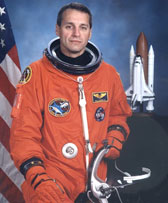 |

|
|
||||
|
Richard M. Linnehan (DVM) NASA BIOGRAPHY Posted: January 7, 2002 PERSONAL DATA: Born September 19, 1957, in Lowell, Massachusetts. Raised by his paternal grandparents, Henry and Mae Linnehan. Single. He enjoys various sports, outdoor activities and natural history. His sister, Colleen, resides in Nevada. EDUCATION: Attended Alvirne High School, Hudson, New Hampshire from 1971-1974. Graduated from Pelham High School, Pelham, New Hampshire, in 1975. Attended Colby College in Waterville, Maine and the University of New Hampshire in Durham, New Hampshire. Graduated from the University of New Hampshire in 1980 with a bachelor of science degree in Animal Sciences with a minor in Microbiology. Received the degree of Doctor of Veterinary Medicine from The Ohio State University College of Veterinary Medicine in 1985. ORGANIZATIONS: Member of the American Veterinary Medical Association, the American Association of Zoo Veterinarians, and the International Association of Aquatic Animal Medicine. Faculty member at the North Carolina State University College of Veterinary Medicine in Raleigh-Durham, North Carolina. Board member of the Tulane/Xavier/NASA Astrobiology Center, New Orleans, Louisiana. SPECIAL HONORS: Navy Group Achievement Award, Navy Commendation Medal, two NASA Space Flight Medals (1996, 1998), NASA Outstanding Leadership Medal (1999), AVMA President's Award, The OSU College of Veterinary Medicine Alumni Award, and The University of New Hampshire Distinguished Alumni Award. EXPERIENCE: After graduating from The Ohio State University College of Veterinary Medicine in June 1985, Dr. Linnehan entered private veterinary practice and was later accepted to a 2-year joint internship in zoo animal medicine and comparative pathology at the Baltimore Zoo and The Johns Hopkins University. After completing his internship Dr. Linnehan was commissioned as a Captain in the U.S. Army Veterinary Corps and reported for duty in early 1989 at the Naval Ocean Systems Center, San Diego, California, as chief clinical veterinarian for the U.S. Navy's Marine Mammal Program. During his assignment at the Naval Ocean Systems Center Dr. Linnehan initiated and supervised research in the areas of cetacean and pinniped anesthesia, orthopedics, drug pharmacokinetics and reproduction in direct support of U.S. Navy mobile marine mammal systems stationed in California, Florida, and Hawaii. NASA EXPERIENCE: Selected by NASA in March 1992, Dr. Linnehan reported to the Johnson Space Center in August 1992 where he completed one year of Astronaut Candidate training qualifying him for Space Shuttle flight assignments as a mission specialist. Dr. Linnehan was initially assigned to flight software verification in the Shuttle Avionics Integration Laboratory (SAIL). He was subsequently assigned to the Astronaut Office Mission Development Branch, working on payload development, and mission development flight support for future Space Shuttle missions. A veteran of two space flights, Dr. Linnehan has logged over 787 hours in space. He first flew as a mission specialist in 1996 on STS-78, the Life Sciences and Microgravity Spacelab (LMS) mission. In 1998, he served as the payload commander on the STS-90 Neurolab mission. He is currently assigned to upgrade and service the Hubble Space Telescope as a member of the 4 man EVA crew on STS-109 scheduled for launch early in 2002. SPACE FLIGHT EXPERIENCE: STS-78 Life and Microgravity Spacelab (June 20 to July 7, 1996) was the longest Space Shuttle mission to date. The 17-day mission included studies sponsored by ten nations and five space agencies, and was the first mission to combine both a full microgravity studies agenda and a comprehensive life sciences payload. STS-78 orbited the Earth 271 times, covered 7 million miles and logged him 405 hours in space. STS-90 Neurolab (April 17 to May 3, 1998) was his second Spacelab mission. During the 16-day flight the seven person crew aboard Space Shuttle Columbia served as both experiment subjects and operators for 26 individual life science experiments focusing on the effects of microgravity on the brain and nervous system. STS-90 orbited the Earth 256 times, covered 6.3 million miles, and logged him an additional 381 hours in space. Both missions served as a model for future life sciences studies on board the International Space Station.
|

|